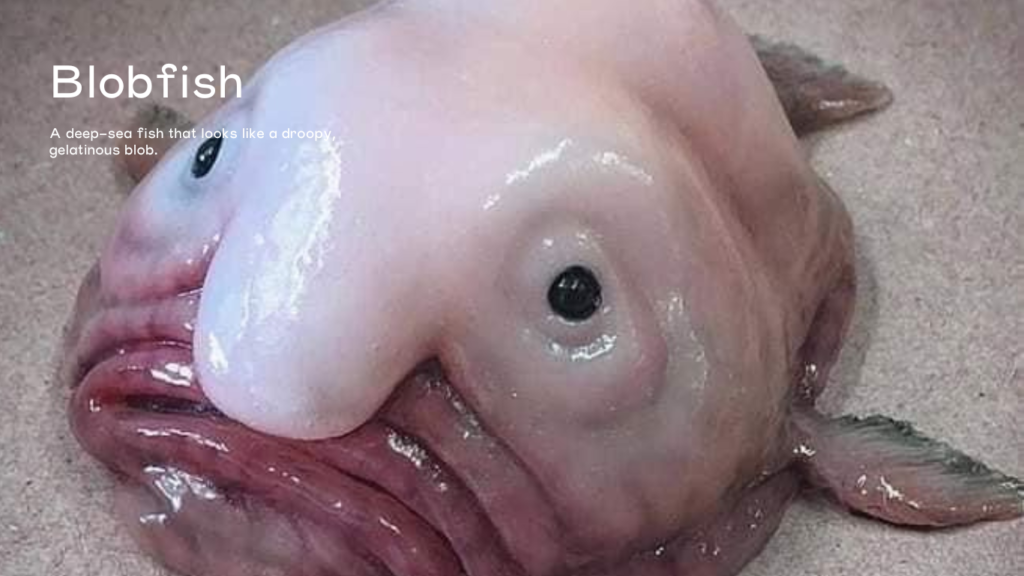The Blobfish: An Unexpected Icon of the Deep Sea
When the blobfish, Psychrolutes marcidus, was voted the world’s ugliest animal in 2013, it became an unlikely symbol of biodiversity. Known for its droopy, gelatinous appearance, the blobfish has since captured the fascination of scientists and the public alike, becoming an enduring symbol of the bizarre and captivating creatures lurking in the ocean’s depths. Despite its unfortunate appearance out of water, the blobfish is an example of extreme adaptation to an environment that is both mysterious and hostile. Here, we delve into the blobfish’s biology, habitat, diet, and the conservation concerns surrounding this unique deep-sea resident.

The Blobfish’s Appearance: A Creature of the Deep
The blobfish is not particularly attractive by typical standards, especially when observed outside of its natural habitat. Its most distinctive feature is its unusual, blob-like shape, which results from the pressure differences between the deep sea and the surface. In the extreme depths of the ocean, where pressures are up to 100 times greater than at sea level, a more rigid body structure would be crushed. The blobfish has therefore adapted by developing a body composed mostly of a gelatinous mass, which gives it a buoyant, blobby form. Its jelly-like body enables it to survive these immense pressures, as it does not rely on a swim bladder like most fish to maintain buoyancy.
In its native habitat, the blobfish appears much more compact, as the pressure provides structure and definition to its features. However, once brought to the surface, its body expands, and the jelly-like tissues lose form, resulting in the famous “droopy” appearance. Out of water, its face sags, its mouth and nose seem to droop, and it takes on a comical, sad expression, contributing to its reputation as the “world’s ugliest animal.”
Read to Aye-Aye: The Mysterious Primate of Madagascar
Habitat: A Life in the Abyss
Blobfish inhabit the cold, dark waters off the coasts of Australia, Tasmania, and New Zealand, typically residing at depths between 2,000 and 4,000 feet (600 to 1,200 meters). At these depths, sunlight is scarce, and temperatures are low. The ocean floor in these regions is largely uncharted and inhospitable, but the blobfish is perfectly adapted to survive here.
The blobfish’s low-density, gelatinous body is well-suited to its deep-sea lifestyle, as it allows the fish to remain buoyant without expending much energy. In an environment where food is scarce, energy conservation is essential. Blobfish typically hover just above the sea floor, where they can easily consume the detritus and organic material that drift down from above. This simple, low-energy approach to life allows the blobfish to thrive in a harsh environment with limited resources.
Diet and Feeding Habits: Opportunistic Feeders
Blobfish are opportunistic feeders, meaning they do not actively hunt but rather consume whatever food is available to them. Their diet consists mainly of deep-sea crustaceans, such as crabs, sea urchins, and mollusks. Because they lack teeth, blobfish cannot chew their food and instead swallow it whole.
Since hunting is not feasible for these low-energy animals, they rely on the “sit and wait” strategy. They rest near the ocean floor, expending minimal energy, until food comes within reach. When small invertebrates pass by, the blobfish simply opens its mouth and allows the current to bring food in. This lazy feeding strategy is highly effective in an environment where food sources are unpredictable, helping the blobfish conserve energy in its nutrient-poor surroundings.
Reproduction: A Mystery Beneath the Sea
Relatively little is known about the reproduction of the blobfish due to the challenges of studying them in their deep-sea habitat. However, researchers have observed that blobfish lay eggs in clusters, often found resting in depressions on the ocean floor. Female blobfish may lay up to 100,000 eggs at a time, forming large nests. Some species of blobfish have been observed “guarding” these nests, although it remains unclear if Psychrolutes marcidus exhibits similar behavior.
Deep-sea creatures like the blobfish have long lifespans and low reproductive rates, meaning they do not reproduce often. This adaptation is advantageous for survival in the deep ocean, where harsh conditions mean fewer predators and less competition. However, it also makes blobfish populations more vulnerable to environmental changes and human activities.
Conservation Concerns: The Threat of Deep-Sea Trawling
Though blobfish are rarely encountered by humans, they are not immune to the impact of human activities. Deep-sea trawling, a commercial fishing method that involves dragging large nets across the ocean floor, poses a significant threat to blobfish populations. This fishing practice disrupts ecosystems, damaging fragile habitats and capturing unintended marine life, known as bycatch.
The blobfish, which lives near the seabed, is highly susceptible to becoming bycatch in deep-sea trawling nets. Once brought to the surface, these fish do not survive due to the drastic pressure changes. Although they are not directly targeted by fisheries, blobfish suffer from habitat destruction and high mortality rates as bycatch. The IUCN (International Union for Conservation of Nature) does not currently list the blobfish as an endangered species, largely because of a lack of data. However, researchers worry that deep-sea trawling, combined with climate change and other environmental factors, could impact blobfish populations and other deep-sea creatures.
Blobfish in Popular Culture: A Strange Fame
Despite its elusive nature, the blobfish has gained popularity in popular culture as a symbol of unconventional beauty and resilience. In 2013, it was named the mascot of the Ugly Animal Preservation Society, an organization dedicated to raising awareness about endangered and lesser-known animals. This designation has helped shine a spotlight on the blobfish and other unusual species that are often overlooked in conservation efforts.
Blobfish have appeared in internet memes, cartoons, and plush toys, and have been celebrated as a symbol of embracing uniqueness and differences. Its “ugly” label has led to an outpouring of affection from fans who find beauty in its odd appearance and commend its survival in extreme environments. Through its unexpected fame, the blobfish has also contributed to conversations about marine conservation and the need to protect habitats that are rarely seen but vital to the Earth’s biodiversity.
The Future of the Blobfish: Preserving Deep-Sea Ecosystems
Protecting blobfish and other deep-sea species requires a combination of conservation efforts, scientific research, and regulation of fishing practices. Many conservationists advocate for stricter regulations on deep-sea trawling, as it has far-reaching effects on ocean ecosystems. There is also a need for more funding and research to better understand the biology and ecology of blobfish and other deep-sea organisms.
Advancements in deep-sea exploration technology, such as remotely operated vehicles (ROVs) and autonomous underwater vehicles (AUVs), offer hope for researchers seeking to learn more about deep-sea habitats. These technologies enable scientists to explore extreme ocean depths without disturbing the creatures that live there, providing valuable data for conservation efforts.
In the face of environmental threats, the blobfish reminds us of the complex and interconnected nature of marine ecosystems. Although it may never be celebrated for its looks, the blobfish is a fascinating example of adaptation and survival, thriving in one of the most challenging environments on Earth. Its unlikely popularity serves as a reminder that every species, no matter how strange or unattractive, plays a role in maintaining the delicate balance of life in our oceans.
The blobfish’s unique adaptations and strange beauty have led it from obscurity to internet fame, helping to inspire conversations about conservation and marine biodiversity. As we continue to explore and understand the ocean’s depths, creatures like the blobfish reveal the remarkable diversity and resilience of life on our planet. Through continued conservation efforts and a greater appreciation for deep-sea ecosystems, we can help protect these bizarre yet vital species for future generations.








